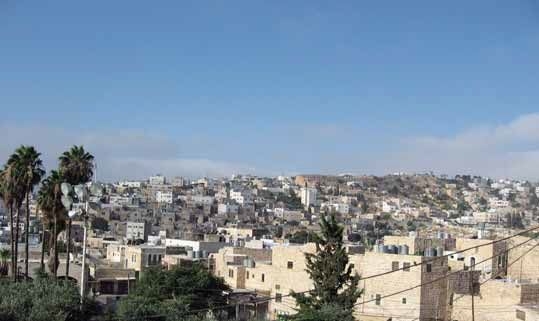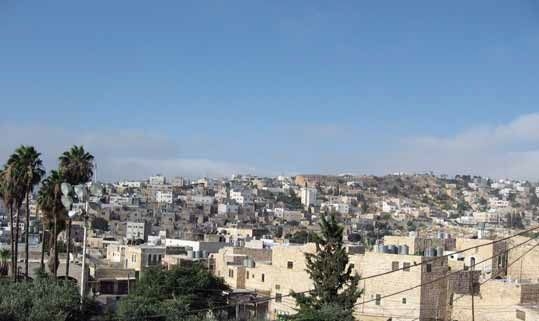Hebron Without Apologies
THERE used to be, and perhaps still is, an American Jewish stand-up comic named Jackie Mason. He is in his nineties if he is still alive. In his younger days performing in New York, at Catskills resorts, in Las Vegas, and on American network television, he was famous for making people upset. He upset TV show host Ed Sullivan, for example, by thumbing his nose at him in front of a live, national TV audience one night in 1962. Ed responded to this lapse in judgment by throwing Jackie off his popular TV show and keeping him off all of network television for more than 10 years. Jackie upset Frank Sinatra by making jokes at a Las Vegas nightclub about the latter's short but tempestuous marriage to actress Mia Farrow, who was thirty years younger than Sinatra. Frank expressed his displeasure at Jackie's intemperate repartee by sending three goons to Jackie's dressing room, who in turn beat Jackie to a pulp. But most of all, Jackie Mason upset the Jews.
For while other Jewish comedians of his generation - and even those of the generation before - had long ago abandoned Yiddish, Jewish mannerisms and Borscht Belt shtick, Mason, born Yacov Moshe Maza and the scion of four generations of orthodox rabbis, literally flaunted his Jewishness and made it the driving force of his act. In a thick Lower East Side of New York Jewish accent, heavily spiced with Yiddish, Jackie talked about Jews and Gentiles, Gentiles and Jews, to the point where other Jewish comedians like Billy Crystal would grimace and say, "That guy makes me feel like a Gentile! "American Jews of my generation were always a little ambivalent about Jackie - laughing somewhat guardedly at his jokes while nervously hoping that none of our non-Jewish friends were listening. In his later years, Jackie would wind up his act by saying, "I can already tell you what the reviews of this show will be like. The Gentiles will say, 'He was terrific-a big hit!' The Jews will say, 'Oy, too Jewish!' Ladies and gentlemen, I ask you, do the Irish go to a James Galway concert and say that he's 'too Irish'? Do the Spanish listen to Andres Segovia and kvetch that he's 'too Spanish'? No! Only the Jews would walk out of here complaining that I'm 'too Jewish'! "On reflection, one has to concede that Jackie had a point. There is probably no other group of people in the world that exhibits the same degree of discomfort and ambivalence about its own manners, customs, heritage, traditions, religious activities and beliefs as ourselves.
Anyone who, like myself, grew up secular and assimilated in the Diaspora can attest that for any one Jew who was religiously observant, proud of his traditions, and unabashedly Jewish, there were at least five other Jews who found him strange, distasteful and embarrassing. Every Irish kid growing up in South Boston or nearby Charlestown marching in St. Patrick's Day parades, waving shamrock banners and proudly wearing green, had at least one young Jewish counterpart in Brooklyn or Newton who felt either awkward or hostile about any public display of Jewishness. And who can forget the queasy reaction of so many American Jews to Menachem Begin's sudden appearance on the world stage back in 1977? "Oy, too Jewish! "- almost like Jackie Mason, but without the jokes. Before I moved to Israel, I was warned that I'd be living in a country where roughly half of the population would be happy, while the other half would be busy wondering why. I was told, mostly by Israelis, that the country was severely divided and, as we all know, it indeed is. Here, we not only have the time-honored Diaspora distinction between the religious and not-so-religious, we also have the yawning divide between the spectacularly religious and militantly secular, right vs. left, Zionist vs. "post- Zionist," and zealous religious nationalism vs. a kind of secular liberal cosmopolitanism. And, throughout virtually all of the dichotomies that characterize life here in Israel, it often seems that one Jew's meat is another Jew's poison.
Case in point: Hebron. Just whisper the name and watch people's faces. Perhaps no other word in any known language so typifies everything that is special about Israel to some Jews, or everything that is wrong with Israel to others. Like a Rorschach test, the word "Hebron "evokes vivid, deep-seated images and emotions. To some of us, Hebron means "holy," one of the four holy cities of the ancient Land of Israel, second holiest place in Judaism, King David's first capital, birthplace of Jewish sovereignty in Israel and site of the Cave of Machpela and the Tomb of the Patriarchs - resting place of Abraham, Isaac and Jacob; Sarah, Rivka and Leah. Mention Hebron to other Jews, however, and their imaginations explode with images of the "Occupation"; barbed wire and checkpoints; neighborhoods ringed with Israeli tanks; and violent, fanatical ultraright wing settlers - always ferocious looking on CNN, and many of them women - glowering angrily into TV cameras, beating up Palestinian news photographers and terrorizing their Arab neighbors. There is, however, another way to look at Hebron. Forget the politics for just a moment and give your religious beliefs, or disbeliefs, a short "time out". Hebron is about more than Jew vs. Arab and Jew vs. Jew. Hebron is history, archeology, folklore and legend. Hebron is a capsule history of Near Eastern urban life, culture, architecture and art. Hebron is prehistoric, early historic, Bronze Age, Iron Age, Classical, Byzantine, Medieval and Modern.
A treasure trove for archaeologists, historians of religion and chroniclers of Western Civilization, Hebron - already ancient when Athens and Rome were brand new - is special and someplace you really should see. One of the oldest and longest continually occupied cities in the world, Hebron probably dates back to the Neolithic period, a time when people were beginning to settle down in small villages and support themselves with agriculture instead of nomadic hunting and food gathering. Archaeology reveals that Hebron was a thriving Bronze Age Canaanite city at around 3500 BCE. Conquered by Joshua and the Israelites, it became first the center and stronghold of the tribe of Judah, and later the first capital of the united Kingdom of Israel, where David ruled for some seven years before conquering Jerusalem. Following the Biblical period, Hebron became a prize to be fought for, died for, won and lost by a succession of new civilizations and their armies. With the destruction of the Second Temple in 70 CE, Judean sovereignty yielded to Roman occupation, followed in turn by Byzantine Christianity, Sassanid Persian invasion, Muslim conquest, two centuries of Medieval warfare between Arabs and Crusaders - culminating in some spectacular battles between Saladin and Richard the Lionheart - Mamluke government, and then four centuries of Ottoman rule, followed by British Mandate administration, Jordanian control, and now Israel's return to the city of its birth.Among Hebron's most famous attractions are the 5,000-year-old Oak of Mamre, where Abraham is reputed to have pitched his tent, the Well of Abraham, as well as the tombs of commander of King David's army Abner Ben Ner, David's Moabite ancestor Ruth, and David's father Jesse. But Hebron's primary attraction is, of course, the Tomb of the Patriarchs at the Cave of Machpela.
The Biblical account relates that Abraham purchased the Cave from a Hittite named Ephron for 400 silver shekels as a burial place for his family, following the death of his wife Sarah. Jewish, Christian and Muslim belief affirm that the Cave is indeed the resting place of Abraham and Sarah, Isaac and Rebecca, and Jacob and Leah. Midrashic sources identify it as also the resting place of the head of Esau; Islamic sources as also the true Tomb of Joseph. King Herod the Great, among the greatest builders in world history, constructed the rectangular enclosure around the Cave which still stands today. The only completely intact Herodian structure anywhere in Israel, the enclosure consists of 6 foot-thick stone walls made of dressed stones that are three feet high and up to 24 feet in length. Later centuries saw a basilica built within the enclosure by the Byzantines, which was later torn down by the Persians, replaced with a mosque and some additional buildings by the Arabs, transformed again into a church by the Crusaders, and rebuilt as a mosque by the Mamelukes. The Mamelukes also constructed the six cenotaphs, or grave markers, for the Patriarchs and Matriarchs - distributing them more or less evenly throughout the enclosure - and made the entire structure an enormous roofed mosque. Jews were not allowed to enter the enclosure, but were permitted to pray on a staircase outside the southeast entrance -provided they did not rise above the seventh step. This rule was maintained in force throughout the subsequent Ottoman period. The stairs are now gone and that entrance closed, but some Jews continue to pray there. Today, the building is divided between Jews and Muslims, with Muslims controlling some 81 percent, including the cenotaphs of Isaac and Rebecca and the only known entrance to the actual burial cave. The remaining area, at the western end of the building, contains the cenotaphs of Abraham and Sarah, Jacob and Leah, and is restricted to Jews. Jews enter the enclosure at the southwestern entrance to the building; Muslims enter at the building's northeast. The two groups are kept apart.
All things considered - like 4,000 years of spectacular history, the fervent beliefs of three world religions, and the bitter drama of current international politics-there is probably no other place on earth quite like the Tomb of the Patriarchs, aside from Jerusalem's Temple Mount. Regardless of who you are, how you vote, and what you do or do not believe, the fabled Tomb and the ancient city that surrounds it, comprise a treasure of world heritage that one would have to be crazy to live near and not see









Comments